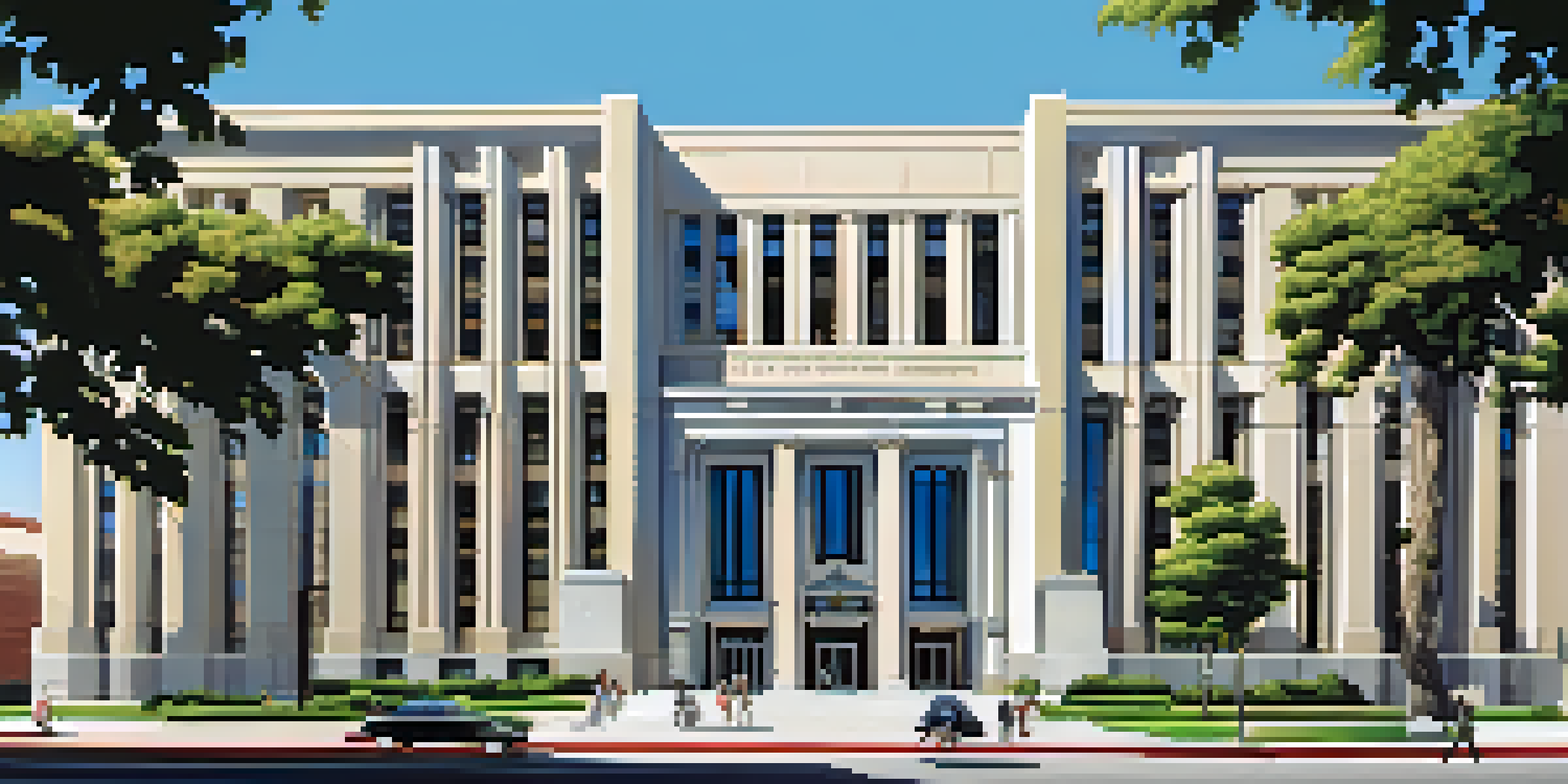Art Deco Influences in Compton: A Historical Overview

Understanding Art Deco: A Brief Introduction
Art Deco is a design movement that emerged in the 1920s and 1930s, characterized by its bold geometric shapes and vibrant colors. Originating in France, it quickly spread across the globe, influencing everything from architecture to fashion. In Compton, this movement left a distinct mark on the city's aesthetic, blending modernity with its unique cultural identity.
Architecture is the learned game, correct and magnificent, of forms assembled in the light.
The term 'Art Deco' comes from the 1925 Exposition Internationale des Arts Décoratifs et Industriels Modernes held in Paris, showcasing the elegance and innovative spirit of the era. This style was a departure from the ornate designs of the previous periods, favoring streamlined forms and functionality. As Compton began to develop in the early 20th century, these design principles began to resonate with local architects and builders.
Understanding the roots of Art Deco helps appreciate its impact on Compton's buildings and public spaces. The movement's emphasis on luxury and modernity mirrored the aspirations of many Compton residents during its growth, making Art Deco a pivotal part of the city’s cultural tapestry.
The Rise of Art Deco Architecture in Compton
As Compton grew in the 1920s, architects began to adopt the Art Deco style, leading to the construction of iconic buildings. Structures like the Compton Courthouse and the original Compton High School showcase the movement's characteristic features—think sleek lines, stylized motifs, and rich materials. This architectural shift marked a significant transformation in the city’s skyline.

Art Deco architecture in Compton is not just about aesthetics; it also reflects the social and economic climate of the time. The prosperity of the Roaring Twenties allowed for ambitious construction projects, giving rise to a sense of optimism and forward-thinking. Buildings designed in this style often served as public landmarks, enhancing community pride.
Art Deco's Influence on Compton
Art Deco emerged in the 1920s and 1930s, leaving a significant mark on Compton's architecture and cultural identity.
This architectural trend was not confined to public buildings. Many residential homes also embraced Art Deco elements, featuring decorative façades and unique designs that set them apart from traditional styles. These homes contributed to a distinctive neighborhood character that residents still cherish today.
Key Examples of Art Deco Structures in Compton
Several notable examples of Art Deco architecture can be found throughout Compton, each telling its own story. The Compton Courthouse, completed in 1939, stands as a testament to the city's dedication to modern governance and community services. Its sharp angles and decorative details make it a prime example of the style.
Art is the most beautiful of all lies; it is a lie that reveals the truth.
Another significant structure is the historic Compton Depot, which once served as a hub for rail travel. Its design incorporates typical Art Deco features, such as the use of bold colors and geometric patterns. Although its original purpose has changed, the building remains a cherished landmark in the community.
These structures not only highlight the artistic influence of the time but also serve as a reminder of the city's heritage. They invite both residents and visitors to appreciate the rich history of Compton through the lens of Art Deco design.
Cultural Significance of Art Deco in Compton
The cultural significance of Art Deco in Compton extends beyond mere aesthetics; it embodies the city's evolving identity. During the peak of the Art Deco movement, Compton was home to a diverse population, and the architecture reflected this multiculturalism. The style became a means of self-expression for various communities, integrating local elements into the broader Art Deco narrative.
As Compton faced various social challenges throughout the decades, the Art Deco buildings stood as symbols of resilience. They represent a time when the city was flourishing and serve as reminders of the artistic spirit that thrives within the community. This historical context adds layers of meaning to the buildings, making them more than just structures.
Preservation Challenges Ahead
Despite its cultural significance, many Art Deco structures in Compton face threats from urban development and limited funding for preservation.
In celebrating these Art Deco influences, the community fosters a sense of pride in its heritage. Events and initiatives aimed at preserving these architectural treasures help to keep the spirit of the era alive, ensuring that future generations appreciate and understand Compton's artistic legacy.
Challenges in Preserving Art Deco Heritage
Despite the rich history and cultural significance of Art Deco in Compton, preservation efforts face numerous challenges. Urban development and modernization often prioritize new construction over historical integrity, leading to the demolition of iconic buildings. As a result, many Art Deco structures are at risk of being lost to time.
Additionally, funding for preservation projects can be limited, making it difficult to maintain and restore these architectural gems. Community advocacy plays a crucial role in raising awareness about the importance of these buildings, but it often requires significant effort and resources. Without a collective commitment, the legacy of Art Deco in Compton could diminish.
Nevertheless, local organizations and passionate residents continue to champion the cause of preservation. By engaging the community and highlighting the value of these structures, they work towards ensuring that Compton's Art Deco heritage is not only recognized but also celebrated.
The Future of Art Deco in Compton
Looking ahead, the future of Art Deco in Compton holds both challenges and opportunities. While the threat of modernization looms, there's also a growing movement to embrace and restore historical architecture. More residents and local leaders are recognizing the potential of these buildings to enrich the community's identity and attract tourism.
Potential restoration projects are often met with enthusiasm, as they aim to breathe new life into the city's Art Deco treasures. By repurposing these structures for modern use, such as restaurants, shops, or community spaces, Compton can create a blend of old and new that respects its heritage while serving contemporary needs. This approach not only preserves history but also fosters economic development.
Community Initiatives Celebrate Heritage
Local events and initiatives aim to promote awareness and appreciation for Compton's Art Deco history, fostering a sense of community pride.
Engaging the younger generation in these efforts is essential for a sustainable future. Educational programs and community events centered around Compton's Art Deco history can instill a sense of pride and responsibility in preserving the city's unique architectural landscape. The combination of advocacy, restoration, and education could ensure that Art Deco continues to thrive in Compton for years to come.
Celebrating Art Deco: Community Initiatives and Events
To honor the rich Art Deco heritage, various community initiatives and events have emerged in Compton. These celebrations often include guided tours, art exhibits, and workshops that focus on the history and impact of Art Deco in the city. Such activities not only educate residents but also engage them in the preservation process.
Local artists and historians frequently collaborate to create projects that showcase the unique features of Art Deco architecture. By integrating art and history, these initiatives foster a deeper appreciation for the city's architectural landscape, encouraging community involvement. Events like street fairs or festivals often highlight the contributions of Art Deco to Compton's identity.

Through these community-driven efforts, the legacy of Art Deco continues to inspire pride and connection among residents. By celebrating this architectural style, Compton can reaffirm its commitment to preserving its cultural and historical roots while looking toward a vibrant future.